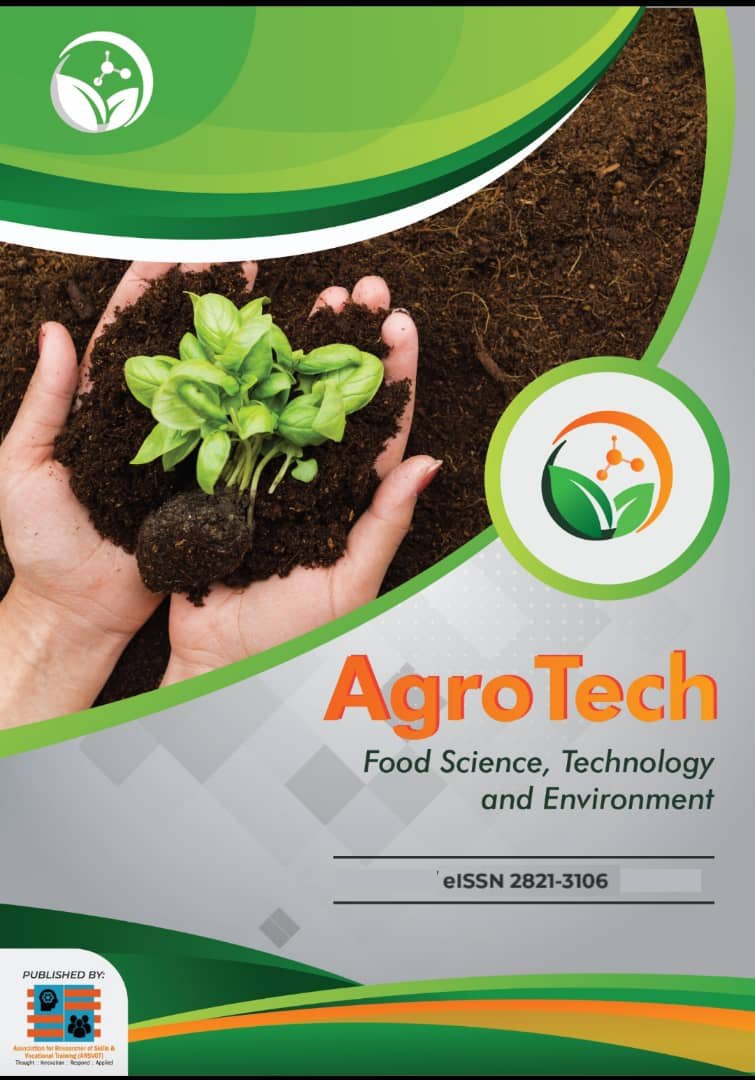Influence of Slurry-Fertigation of Maize (Zea Mays) Production on Nutrient-Depleted Sand-Loam Soil
DOI:
https://doi.org/10.53797/agrotech.v2i2.3.2023Keywords:
Depleted, Maize, Production, Slurry-fertigationAbstract
Attempt to improve the standard of living and maintain a natural environment with crop production for a healthy man living, the use of different soil amendments to upgrade agricultural soils are of great concern in this millennium. The use of animal wastes for crop production and to reduce the menace of these wastes in man’s environment must also be considered. Hence, a field experiment was carried out at Lagos State University of Education, Michael Otedola Campus, Teaching and Research Farm, Epe Lagos using pig and poultry wastes; prepared into a slurry and applied at different rates for maize production under field conditions. The experimental design was randomized complete block design (RCBD) with six treatments; which are: NFE-Control, Pig dung (0.6, 1.2 and 1.8 kg/ 3.6 m2) and Poultry dung (0.6, 1.2 and 1.8 kg/ 3.6 m2) and replicated three times. From this study, animal waste slurry for maize production increased both the vegetative growth and maize grain yield. Maize Plant Height (PH, cm), at 4 weeks after sowing ranged from 19.8±8.8 – 33.1±8.8 under NFE and Poultry dung (0.6kg) applications, and 50.8±18.9 – 93.4±18.9 under NFE and Pig manure (1.8kg) application at 6 weeks after sowing. Both Poultry and Pig dung slurry at 0.6kg - 1.8kg/3.6 m2 on nutrient-depleted soil gave grains yield ranging from 1.1 to 2.0 t/ha. As a result, the application of these dungs increased the growth and yield of maize and is thus recommended for maize production.
Downloads
References
Abubakar, Z. A., & Ali, A. D. (2018). Screening effect of organic manure on the vegetative growth of maize (Zea May L.). Journal of Bioscience and Agriculture Research, 16(2), 1356-1364.
Adekunle, S.M. (2014). Influence of fertilizer rates on growth of selected immature rubber (Hevea brasiliensis
Muell. arg) clones grown on two soil series. Thesis, Master of Science, Faculty of Agriculture, Universiti Putra Malaysia.
Adejumo, T. O., Hettwer, U., & Karlovsky, P. (2007). Occurrence of Fusarium species and trichothecenes in Nigerian maize. International journal of food microbiology, 116(3), 350-357.
Ahmed, F., Mondal, M., & Akter, M. (2019). Organic fertilizers effect on potato (Solanum tuberosum L.) tuber production in sandy loam soil. International journal of plant & soil science, 29(3), 1-11.
Block, A., Vaughan, M., Schmelz, E. & Christensen, S. (2018). Biosynthesis and function of terpenoid defence compounds in maize (Zea mays). Planta, 249(1), 21-30.
Dlamini, S. N., Masarirambi, M. T., Wahome, P. K., & Oseni, T. O. (2020). The Effects of organic fertilizers on the growth and yield of Amaranthus (Amaranthus hybridus L.) grown in a lath house. Asian Journal of Advances in Agricultural Research, 12(1), 1-10.
Gashua, A. G., Sulaiman, Z., Yusoff, M. M., Samad, M. Y. A., Ramlan, M. F., & Salisu, M. A. (2022). Assessment of Fertilizer Quality in Horse Waste-Based Bokashi Fertilizer Formulations. Agronomy, 12(4), 937.
Gao, C., El-Sawah, A. M., Ali, D. F. I., Alhaj Hamoud, Y., Shaghaleh, H., & Sheteiwy, M. S. (2020). The integration of bio and organic fertilizers improves plant growth, grain yield, quality and metabolism of hybrid maize (Zea mays L.). Agronomy, 10(3), 319.
Liverpool-Tasie, L. S. O., Turna, N. S., Ademola, O., Obadina, A., & Wu, F. (2019). The occurrence and co-occurrence of aflatoxin and fumonisin along the maize value chain in southwest Nigeria. Food and Chemical Toxicology, 129, 458-465.
Mahmood, F., Khan, I., Ashraf, U., Shahzad, T., Hussain, S., Shahid, M. & Ullah, S. (2017). Effects of organic and inorganic manures on maize and their residual impact on soil physico-chemical properties. Journal of soil science and plant nutrition, 17(1), 22-32.
Mutlu, A. (2020). The effect of organic fertilizers on grain yield and some yield components of barley (Hordeum vulgare L.). Fresenius Environmental Bulletin, 29(12), 10840.
Olatunji, K. O., Adebayo, A. O., & Bolaji, G. E. (2020). Investigating organic manure and inorganic fertilizer for sustainable maize (Zea mays) production in Southwestern Nigeria. Asian Journal of Environment & Ecology, 13, 31-40.
Rus, R. C., Salisu, M. A., & Usaizan, N. (2023). Influence of Composition of Soilless Substrates Monitored with IoT Sensor Nodes on the Growth, Nutrient and Fruit Quality of Rockmelons (Cucumis melo Var. Cantalupensis). Indian Journal of Agricultural Research, 1, 7.
Salisu, M., Daud, N., & Ahmad, I. (2013). Influence of fertilizer rates and soil series on growth performance of natural rubber ('Hevea brasiliensis') latex timber clones. Australian Journal of Crop Science, 7(13), 1998-2004.
Sekumade, A. B. (2017). Economic effect of organic and inorganic fertilizers on the yield of maize in Oyo State, Nigeria. International Journal of Agricultural Economics, 2, 63-68.
Toungos, M. D. (2019). Effect of Organic and Inorganic Fertilizers on Yield of Maize in Mubi North Local Government Area, Adamawa State, Nigeria. International Journal of Innovative Agriculture & Biology Research, 7(2), 26-35.
Downloads
Published
How to Cite
Issue
Section
License
Copyright (c) 2023 arsvot

This work is licensed under a Creative Commons Attribution-NonCommercial-ShareAlike 4.0 International License.



